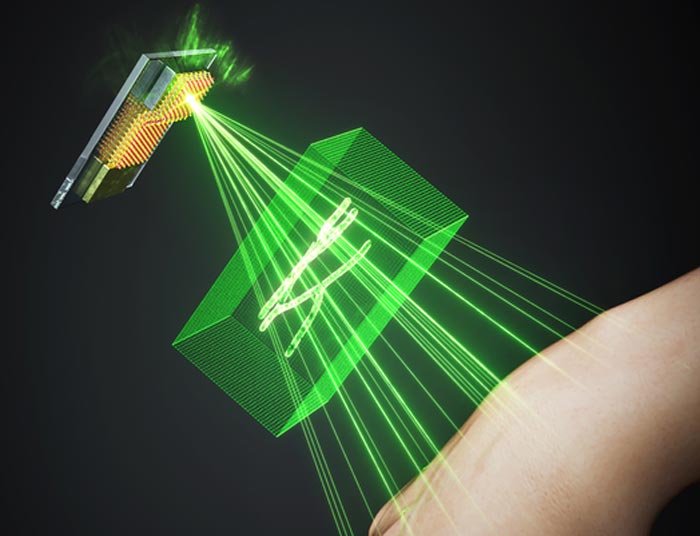3d digital holograms on smartphones?

Schematic diagram of bio-application holograms
Credit: Korea Institute of Science and Technology(KIST)
Realized 3D digital holograms by developing a polarization image sensor with no additional polarization filters. Miniaturization of the entire holographic camera sensor module is possible with follow-up research.
3D holograms, previously seen only in science fiction movies, may soon make their way into our daily lives. Until now, 3D holograms based on phase shifting holography method could be captured using a large, specialized camera with a polarizing filter. However, a Korean research group has just developed technology that can acquire holograms on mobile devices, such as smartphones.
The Korea Institute of Science and Technology (KIST, Director Seok-jin Yoon) recently announced that a research team led by Dr. Min-Chul Park and Dr. Do Kyung Hwang of the Center for Opto-Electronic Materials and Devices, in collaboration with a research team led by Prof. Seongil Im of the Department of Physics at Yonsei University, was successful in developing a photodiode that detects the polarization of light in the near-infrared region without additional polarization filters and thus, the realization of a miniaturized holographic image sensor for 3D digital holograms, using the 2D semiconductor materials: rhenium diselenide and tungsten diselenide.
Photodiodes, which convert light into current signals, are essential components within the pixels of image sensors in digital and smartphone cameras. Introducing the ability to sense the polarization of light to the image sensor of an ordinary camera provides a variety of new information, enabling the storage of 3D holograms. Previous polarization-sensing cameras have an additional polarization filter, several hundred micrometers in size, attached to an ultra-small optical diode image sensor, less than a micrometer in size. Thus, they could not be implemented into portable electronic devices because of their inability to be integrated and miniaturized.
The research group developed a photodiode by stacking an n-type semiconductor, rhenium diselenide, which exhibits a difference in light absorption dependent on the linear polarization angle of light in the near-infrared (980 nm) region, and a p-type semiconductor, tungsten diselenide, which exhibits no difference in photo-response dependent on polarization, but enables superior performance. The device is excellent in the photodetection of various wavelengths from ultraviolet to near-infrared, even capable of selectively detecting the polarization characteristics of light in the near-infrared region. The research group utilized the device to create a digital holographic image sensor that records polarization characteristics to successfully capture holograms.
Dr. Hwang of KIST said, “Research on the downsizing and integration of individual elements is required to ultimately miniaturize holographic systems. The results of our research will lay the foundation for the future development of miniaturized holographic camera sensor modules.” In addition, Dr. Park remarked, “The new sensor can further detect near-infrared light, as well as previously undetectable visible light, opening up new opportunities in various fields such as 3D night vision, self-driving, biotechnology, and near-infrared data acquisition for analyzing and restoring cultural assets.”
The Korea Institute of Science and Technology (KIST). Founded as the first multidisciplinary government-funded research institute in Korea, KIST established a national development strategy based on science and technology and disseminated various essential industrial technologies. Now, half a century later, KIST is elevating Korea’s status in the field of science and technology through world-leading fundamental technology R&D. Looking to the future, KIST will continue to strive to be a premier research institute, pursuing a brighter future for Korea and all of humanity.
This research was supported by the Korean Ministry of Science and ICT(Minister Heysook Lim) as a KIST Institutional R&D Projects and by the Korean Ministry of Culture, Sports, and Tourism(Minister Hwang, Hee) as a cultural technology R&D project of the Korea Creative Content Agency- Culture, Arts, Sports, and Tourism Technology Promotion Center. The results have been published in the November issue of ACS Nano (IF: 15.881).
Journal: ACS Nano
DOI: 10.1021/acsnano.1c06234
Article Title: Near-Infrared Self-Powered Linearly Polarized Photodetection and Digital Incoherent Holography Using WSe2/ReSe2 van der Waals Heterostructure
Article Publication Date: 22-Oct-2021
All latest news from the category: Physics and Astronomy
This area deals with the fundamental laws and building blocks of nature and how they interact, the properties and the behavior of matter, and research into space and time and their structures.
innovations-report provides in-depth reports and articles on subjects such as astrophysics, laser technologies, nuclear, quantum, particle and solid-state physics, nanotechnologies, planetary research and findings (Mars, Venus) and developments related to the Hubble Telescope.
Newest articles

A universal framework for spatial biology
SpatialData is a freely accessible tool to unify and integrate data from different omics technologies accounting for spatial information, which can provide holistic insights into health and disease. Biological processes…

How complex biological processes arise
A $20 million grant from the U.S. National Science Foundation (NSF) will support the establishment and operation of the National Synthesis Center for Emergence in the Molecular and Cellular Sciences (NCEMS) at…

Airborne single-photon lidar system achieves high-resolution 3D imaging
Compact, low-power system opens doors for photon-efficient drone and satellite-based environmental monitoring and mapping. Researchers have developed a compact and lightweight single-photon airborne lidar system that can acquire high-resolution 3D…





















